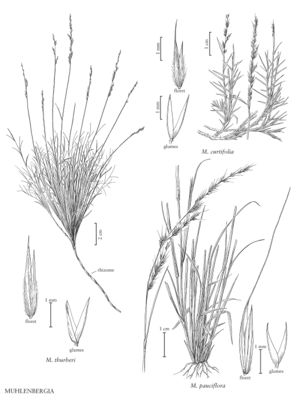Muhlenbergia pauciflora
Plants perennial; tightly cespitose, sometimes rhizomatous. Culms 30-70 cm tall, 0.7-1 mm thick, erect, geniculate and rooting at the lower nodes; internodes mostly glabrous, sometimes glaucous, often striate below the nodes. Sheaths usually shorter than the internodes, smooth or scabridulous, usually with dark brown necrotic spots, flat and spreading at maturity; ligules 1-2.5(5) mm, membranous, obtuse, with lateral lobes 1.5-3 mm longer than the central portion; blades (1)5-12(15) cm long, 0.5-1.5 mm wide, flat to involute, glabrous and smooth abaxially, scabridulous adaxially, often with dark brown necrotic spots. Panicles (2)5-15 cm long, 0.5-2.8 cm wide, contracted, interrupted below; primary branches 0.5-4(6) cm, appressed or diverging up to 30° from the rachises, spikelet-bearing to the base; pedicels 0.1-3 mm, scabrous. Spikelets 3.5-5.5 mm, occasionally with 2 florets. Glumes equal, 1.5-3.5 mm, shorter than the lemmas, 1-veined, acuminate to acute, often erose, unawned or awned, awns to 2.2 mm; lemmas 3-5.5 mm, lanceolate, often purplish, mostly glabrous, calluses with a few short hairs, apices acuminate, scabridulous, awned, awns (5)7-25 mm, flexuous; paleas 3-5.5 mm, lanceolate, glabrous, acuminate; anthers 1.5-2.1 mm, yellowish or purplish. Caryopses 2-2.5 mm, fusiform, brownish. 2n = unknown.
Distribution
Colo., N.Mex., Tex., Utah, Calif., Ariz.
Discussion
Muhlenbergia pauciflora grows in open or closed forests on rocky slopes, cliffs, canyons, and rock outcrops of granitic or calcareous origin, at elevations of 1200-2500 m. Its range extends from the southwestern United States to central Mexico.
Selected References
None.
